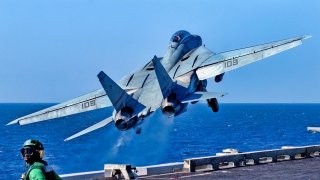Only 1 Country Still Flies the F-14 Tomcat Fighter
Despite the Tomcat’s retirement from U.S. service in 2006, Iran continues to operate 24 of the aircraft. Known for its speed, agility, and long-range AIM-54 Phoenix missiles, the F-14 remains iconic in aviation history.
What You Need to Know: The F-14 Tomcat, renowned for its capabilities, has a notable combat record, though much of its success came from Iran rather than the U.S. Iran's pilots, flying U.S.-supplied F-14s, claimed 130 aerial victories during the Iran-Iraq War, with one pilot, Col. Mostafa Roustaie, achieving ace status. In contrast, U.S. Navy Tomcats tallied five kills: two Libyan Sukhoi Su-22s, two Libyan MiG-23s, and an Iraqi Mi-8 helicopter.

The Bottomline: Despite the Tomcat’s retirement from U.S. service in 2006, Iran continues to operate 24 of the aircraft. Known for its speed, agility, and long-range AIM-54 Phoenix missiles, the F-14 remains iconic in aviation history.
Though not quite as impressive as the F-15 Eagle’s mind-blowing 104:0 air-to-air kill ratio, the Tomcat has a very respectable air-to-air combat performance history.
Perhaps the greatest irony of the Tomcat’s kill tally is that the majority of its scores were achieved not by American pilots, nor even the pilots of a U.S. ally, but rather by the pilots of an adversary nation.
Not just any U.S. adversary, either, but one deemed by then-President George W. Bush to be a member of the “Axis of Evil:” Iran. (Granted, Iran’s F-14s are carryovers from when that nation was actually still a U.S. ally.)
No American Tomcat drivers attained ace status (5 or more aerial victories), but at least one Islamic Republic of Iran Air Force pilot did. IRIAF pilot Col. Mostafa Roustaie, who scored five kills against Iraqi opponents during the Iran-Iraq War, described his beloved plane as “the last word in the fighter business.”
All in all, IRIAF pilots claimed 130 victories versus only 4 losses. However, as noted by aviation expert Tom Cooper in Smithsonian Magazine, “It is impossible to tabulate, for example, how many air-to-air victories were scored by Iranian F-14s because air force records were repeatedly tampered with during and after the war for political, religious, or even personal reasons.”

As for those lucky few Iraqi pilots who managed to kill a Tomcat – rare birds, indeed – the admittedly scanty evidence indicates that two of them did so in a MiG-23 Flogger, while one kill apiece is credited to a Dassault Mirage F1 and a MiG-21 Fishbed.
Iran remains the only nation flying active F-14s. According to estimates in 2019, Iran’s air force maintains 24 F-14 Tomcats from the original batch of 79.
What About America?
As for the total kills scored by U.S. Navy Tomcat fliers, that tally is 5: two Libyan Sukhoi Su-22 Fitter jets downed during the 1981 Gulf of Sidra incident; two Libyan MiG-23 Floggers killed during the 1989 Gulf of Sidra incident; and one Iraqi Mi-8 Hip helicopter downed during Operation Desert Storm in 1991.
No U.S. Navy-flown F-14s have ever been lost in aerial combat, though one F-14 was lost to enemy ground fire during Desert Storm. Its pilot, Lt. Devon Jones, was rescued the next day, while his radar intercept officer, Lt. Lawrence Slade, ended up as a prisoner for the remainder of the war. (Unlike the ill-fated Goose from the original Top Gun film, Mr. Slade lived to tell the tale.)
The F-14 made her maiden flight on Dec. 21, 1970, and officially entered service on Sept. 22, 1974, with the U.S. Navy aboard the USS Enterprise. The aircraft was finally retired from service on the 32nd anniversary of its debut, Sept. 22, 2006.
F-14 Specifications:
Crew: 2 (Pilot and radar intercept officer)
Length: 62 ft 9 in (19.13 m)
Wingspan: 64 ft 1.5 in (19.545 m)
Swept wingspan: 38 ft 2.5 in (11.646 m) swept
Height: 16 ft (4.9 m)
Wing area: 565 sq ft (52.5 sq m) wings only
1,008 sq ft (94 sq m) effective area including fuselage
Maximum speed: Mach 2.34 (1,544 mph, 2,485 km/h) at altitude
Range: 1,600 nmi (1,800 mi, 3,000 km)
Combat range: 500 nmi (580 mi, 930 km)
Service ceiling: 53,000 ft (16,000 m)-plus
Armament: 1× 20 mm (0.787 in) M61A1 Vulcan 6-barreled Gatling cannon, with 675 rounds; AIM-54 Phoenix (the Tomcat’s most unique and exclusive feature) , AIM-7 Sparrow, AIM-9 Sidewinder
About the Author
Christian D. Orr is a former Air Force officer, Federal law enforcement officer, and private military contractor (with assignments worked in Iraq, the United Arab Emirates, Kosovo, Japan, Germany, and the Pentagon). He has also been published in The Daily Torch and The Journal of Intelligence and Cyber Security.


